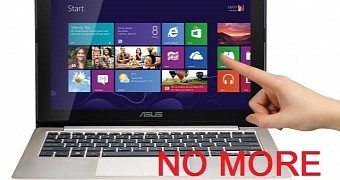It seems that most customers purchasing a laptop today aren't really impressed if the product they are buying comes with a touchscreen or not. For starters, those choosing such a product will have to pay more.
Secondly, most of daily tasks on a notebook can be achieved with a keyboard and a mouse. So there's no really stringent need for a touchscreen.
Notebook vendors say "nay" to touchscreen notebooks
And that’s probably why demand for touchscreen notebooks has been weaker than expected, so notebook manufacturers have ceased the production of touch-enabled models for Q4 2014, say sources familiar with the matter reported by DigiTimes.
Notebook vendors will limit themselves to providing 2-in-1 hybrids with touch-screens, because here the feature is essential to the functioning of the device. 2-in-1s usually come with a screen that can be detached form the keyboard dock, which can be further used as a stand-alone tablet.
However, Ultrabooks, gaming notebooks and traditional notebooks we will see arrive in Q4 will no longer take advantage of this function.
2-in-1s might still have a chance at surviving the fierce battle for existence with the help of Intel’s new Broadwell architecture, which is expected to bring about power-efficient, powerful and sleek machines. 2-in-1s are versatile devices that appeal to mobile professionals but not only.
However, pricing might still be an important issue here. As we have seen, the first Broadwell hybrids to make a debut on the market will come with hefty price-tags. For example, the Lenovo ThinkPad Helix 2 will sell for $999 / €771 while the HP Envy x2 Duo will be marketed for $950 / €734.
Microsoft and Intel are the most impacted by the situation
Going back to the halting of touchscreen notebook production, key players which are impacted the most by these issues outlined above are Microsoft and Intel, both of which aggressively promoted the touch screen function in notebooks.
A few years back, Intel was making bold statements and had big plans for the implementation of touch screens. The chip giant said that Ultrabooks and just about any other Windows 8 device would eventually come with touch. But that obviously didn't happen.
Now, vendors are placing their faith in the advent of Windows 9 which is expected to arrive in 2015 hoping the new software and the hardware to follow it will rekindle customers’ interest in the touch-enabled products.
Interestingly enough, a quick search on Amazon revealed that customers can get a touch screen notebook for as little as $254 / €200 (ASUS X200CA-DB01T). However, most buyers prefer getting a standard notebook with a better configuration, as opposed to getting a touchscreen lappy with lower specs.

 14 DAY TRIAL //
14 DAY TRIAL //